Quick Summary:
- Automotive SEO is vital for online visibility and growth.
- Optimize website content, technical health, and local listings.
- Build trust and authority through user experience and quality backlinks.
- Expect long-term results from continuous, data-driven SEO efforts.
Table of Contents
- What is Automotive Website SEO and Why Does It Matter for Your Business?
- Understanding the Automotive Buyer’s Journey in the Digital Age
- The Cost of Not Ranking: Missed Opportunities and Vanishing Leads
- The Unquestionable Benefits of First-Page Rankings for Automotive Businesses
- Increased Organic Traffic and Qualified Leads
- Enhanced Brand Authority and Trust
- Competitive Advantage
- Sustainable Growth and ROI
- How Google Ranks Automotive Websites: A Deep Dive into Core Factors
- Content is King (Still): Relevance and Value for Automotive Searchers
- Technical SEO: The Engine Under the Hood of Your Automotive Website
- Website Speed and Core Web Vitals
- Mobile-Friendliness (Crucial for Automotive Shoppers)
- Site Structure and Navigation
- Schema Markup for Automotive Businesses (Dealerships, Vehicles, Services)
- XML Sitemaps and Robots.txt
- Secure Sockets Layer (SSL/HTTPS)
- Backlinks and Domain Authority: Your Automotive Website’s Vote of Confidence
- User Experience (UX): Keeping Automotive Visitors Happy and Engaged
- Local SEO: The GPS to Your Automotive Business’s Doorstep
- Google My Business (GMB) Optimization for Automotive
- Local Citations and Directories
- Geo-Targeted Keywords
- The Step-by-Step Blueprint for Automotive Website SEO Success
- Step 1: Comprehensive Keyword Research for the Automotive Niche
- Identifying High-Intent Automotive Keywords (Long-tail, LSI)
- Competitor Keyword Analysis
- Tools for Automotive Keyword Research
- Step 2: On-Page SEO Mastery for Automotive Content
- Crafting Compelling Title Tags and Meta Descriptions
- Optimizing Headings (H1-H6)
- High-Quality Content Creation: Vehicle Descriptions, Service Pages, Blog Posts
- Image Optimization for Automotive Galleries
- Internal Linking Strategies
- Step 3: Technical SEO Implementation and Auditing for Automotive Websites
- Conducting a Technical SEO Audit
- Fixing Crawl Errors and Indexing Issues
- Implementing Structured Data for Automotive
- Step 4: Building a Robust Backlink Profile for Your Automotive Site
- Content-Based Link Building (Guest Posting, Infographics)
- Local Partnerships and Sponsorships
- Broken Link Building
- Step 5: Dominating Local Search with Automotive-Specific Strategies
- Advanced GMB Optimization Tactics
- Encouraging and Responding to Reviews
- Local Landing Pages
- Step 6: User Experience (UX) and Conversion Rate Optimization (CRO)
- Intuitive Navigation and Clear Calls-to-Action
- Fast Loading Times and Mobile Responsiveness
- Personalized User Journeys
- Advanced Automotive Website SEO Strategies to Outpace Competition
- Voice Search Optimization for Automotive Queries
- Video SEO: Showcasing Vehicles and Services
- E-A-T Principles for Automotive Authority
- International SEO (if applicable)
- Leveraging AI in Automotive SEO
- Measuring Your Automotive SEO Success: Key Metrics and Tools
- Essential SEO Metrics for Automotive Businesses
- Organic Traffic and Conversions
- Keyword Rankings
- Domain Authority/Rating
- Local Pack Rankings
- Indispensable Tools for Automotive SEO Analytics
- Google Analytics 4 (GA4)
- Google Search Console
- Local SEO Tools
- Rank Tracking Software
- When to Expect Results from Your Automotive SEO Efforts
- Understanding the SEO Timeline: Patience is a Virtue
- Factors Influencing Your Ranking Speed
- Qrolic Technologies: Your Trusted Partner in Automotive Website SEO Excellence
- Who is Qrolic Technologies?
- How Qrolic Elevates Automotive Businesses to Google’s First Page
- Qrolic’s Proven Approach and Expertise
- The Future of Automotive Website SEO: Staying Ahead of the Curve
- AI and Machine Learning’s Growing Influence
- Personalization and Hyper-Localization
- Continued Emphasis on User Experience
- Final Thoughts: Drive Your Automotive Business to Digital Dominance
What is Automotive Website SEO and Why Does It Matter for Your Business?
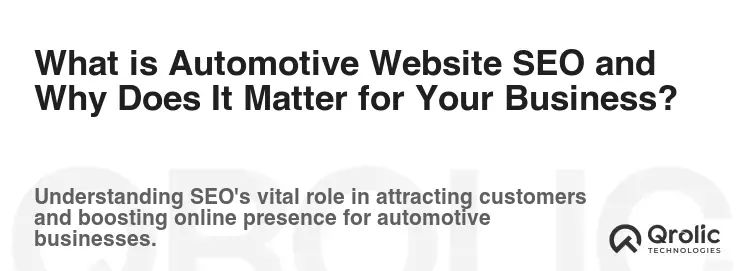
Imagine a vast digital highway, bustling with millions of potential customers, all searching for their next vehicle, a trusted repair shop, or essential auto parts. If your automotive business isn’t visible on that highway, specifically on the very first exit ramp – Google’s first page – you’re essentially invisible. This is where Automotive Website SEO (Search Engine Optimization) becomes not just important, but absolutely critical for your survival and growth in today’s fiercely competitive market.
At its core, automotive website SEO is the strategic process of optimizing your auto-related website to rank higher in search engine results pages (SERPs) for relevant keywords. It’s about making your site irresistible to search engines like Google, so when a potential customer types in “best used cars in [city]” or “oil change near me,” your business isn’t just listed, it’s prominently displayed at the top. This isn’t magic; it’s a methodical application of techniques that align your website with what search engines deem valuable and authoritative.
Understanding the Automotive Buyer’s Journey in the Digital Age
The days of simply walking into a dealership or repair shop without prior research are largely gone. Today’s automotive customer is empowered and informed, and their journey almost invariably begins online. They’re asking questions, comparing options, reading reviews, and envisioning their future purchase or service, often months before they ever step foot on your lot or into your service bay.
- Discovery Phase: “What kind of car do I need?” “How often should I get my tires rotated?”
- Consideration Phase: “Toyota Camry vs. Honda Accord reviews,” “cheapest auto insurance for new drivers,” “best mechanics near [zip code].”
- Decision Phase: “Ford F-150 deals [city],” “schedule test drive [dealer name],” “book brake service [shop name].”
If your website isn’t optimized to appear at each of these crucial touchpoints, you’re losing out on the opportunity to guide them directly to your door. Effective automotive website SEO ensures you’re present and authoritative throughout this complex, multi-stage journey.
The Cost of Not Ranking: Missed Opportunities and Vanishing Leads
Failing to prioritize automotive website SEO is akin to opening a magnificent showroom in a remote, unadvertised location. No matter how great your inventory, services, or prices, if no one can find you, you’re out of business. The consequences of poor rankings are tangible and severe:
- Loss of Organic Traffic: The vast majority of clicks go to the first few results on Google. If you’re on page two or beyond, your website might as well not exist.
- Reduced Lead Generation: Fewer website visitors directly translate to fewer inquiries, test drives, service appointments, and ultimately, fewer sales.
- Diminished Brand Visibility and Trust: High rankings signal authority and trustworthiness. Low rankings suggest obscurity or irrelevance.
- Competitive Disadvantage: Your competitors, who are investing in SEO, will capture the lion’s share of the market, growing stronger while you struggle.
- Higher Advertising Costs: If organic visibility is low, you’re forced to rely more heavily on paid advertising (PPC), which can be expensive and stop delivering results the moment you stop paying.
The Unquestionable Benefits of First-Page Rankings for Automotive Businesses
Securing a spot on Google’s coveted first page for your automotive business isn’t just a goal; it’s a gateway to unparalleled growth and stability. Qrolic’s experience shows that these benefits cascade throughout your entire operation.
Increased Organic Traffic and Qualified Leads
When your automotive website ranks highly, you attract visitors who are actively searching for what you offer. These aren’t just random browsers; they are high-intent individuals, significantly more likely to convert into leads and customers. This organic traffic is also “free” in the sense that you’re not paying per click, making it an incredibly cost-effective long-term strategy.
Enhanced Brand Authority and Trust
Google’s algorithms are designed to present the most reliable and authoritative information to its users. By consistently ranking well, your automotive brand earns a halo of credibility. Consumers inherently trust businesses that Google “recommends” at the top of its search results. This trust translates into easier conversions and stronger customer loyalty.
Competitive Advantage
In a crowded market, standing out is paramount. Stellar automotive website SEO gives you a significant edge over competitors who neglect their digital presence. You’ll capture the attention of potential customers first, allowing you to showcase your unique value proposition before they even consider another option.
Sustainable Growth and ROI
Unlike fleeting ad campaigns, the benefits of strong SEO compound over time. A well-optimized automotive website becomes a perpetual lead-generation machine, driving consistent traffic and sales month after month. The initial investment in SEO delivers a high return on investment (ROI) that continues to pay dividends, fostering sustainable growth for your business.
How Google Ranks Automotive Websites: A Deep Dive into Core Factors
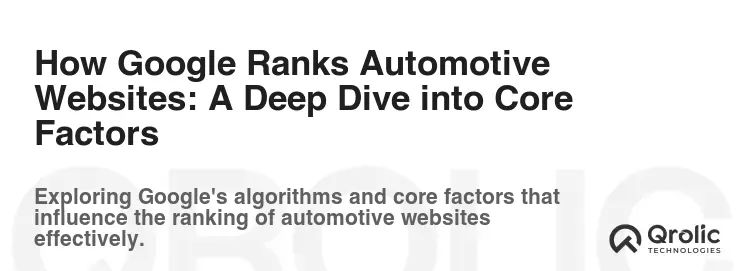
Understanding how Google “thinks” is crucial for any successful automotive website SEO strategy. While Google’s algorithm is complex and constantly evolving, its core mission remains the same: to deliver the most relevant, authoritative, and user-friendly results possible. Qrolic’s insights reveal that success hinges on mastering several key areas.
Content is King (Still): Relevance and Value for Automotive Searchers
Google’s primary goal is to answer user queries effectively. This means your automotive website needs high-quality, comprehensive, and relevant content that directly addresses the needs and questions of your target audience.
- Vehicle Description Pages: More than just specs, these should include benefits, unique selling points, high-quality images, and even videos.
- Service Pages: Detailed explanations of services, why they’re important, and what customers can expect.
- Blog Posts and Articles: Address common automotive questions (e.g., “When to change spark plugs?”, “Electric vehicle range anxiety solutions”), industry news, comparisons, and buying guides.
- Local Landing Pages: Dedicated pages for specific services or locations, rich with local keywords.
The content must be unique, engaging, and genuinely helpful. Google’s algorithms are sophisticated enough to detect thin, keyword-stuffed content and will penalize sites that prioritize quantity over quality. Focus on E-A-T (Expertise, Authoritativeness, Trustworthiness) principles in your content creation.
Technical SEO: The Engine Under the Hood of Your Automotive Website
Technical SEO ensures that search engines can effectively crawl, index, and understand your automotive website. It’s the foundation upon which all other SEO efforts are built. Ignoring technical SEO is like trying to race a car with a faulty engine – you won’t get far.
Website Speed and Core Web Vitals
Google heavily prioritizes user experience, and a slow website is a major turn-off. Especially for automotive shoppers who are often researching on their mobile devices, every millisecond counts. Core Web Vitals (Largest Contentful Paint, First Input Delay, Cumulative Layout Shift) are specific metrics Google uses to evaluate user experience.
- Optimization Tips: Compress images and videos (crucial for image-heavy automotive sites), leverage browser caching, use a fast hosting provider, minify CSS/JavaScript, and implement a Content Delivery Network (CDN).
Mobile-Friendliness (Crucial for Automotive Shoppers)
A significant percentage of automotive searches happen on mobile devices. Google uses mobile-first indexing, meaning it primarily uses the mobile version of your site for indexing and ranking.
- Optimization Tips: Ensure a responsive design that adapts seamlessly to all screen sizes, touch-friendly navigation, readable text without zooming, and fast mobile loading times.
Site Structure and Navigation
A logical and intuitive site structure helps both users and search engines understand your website’s hierarchy and find information easily.
- Optimization Tips: Use a clear hierarchy (e.g., Home > New Vehicles > [Make] > [Model]), breadcrumbs for easy navigation, and internal links that connect related pages.
Schema Markup for Automotive Businesses (Dealerships, Vehicles, Services)
Schema markup (structured data) is code that you add to your HTML to help search engines better understand the content on your pages. For automotive businesses, this is incredibly powerful.
- Optimization Tips: Implement
AutoDealer,Car,Offer,Product,Review, andServiceschema types. This can lead to rich snippets in search results, making your listings stand out with star ratings, prices, and availability.
XML Sitemaps and Robots.txt
- XML Sitemaps: An XML sitemap lists all important pages on your website, guiding search engine crawlers to ensure nothing is missed.
- Robots.txt: This file tells search engine crawlers which parts of your site they shouldn’t crawl (e.g., admin pages).
Secure Sockets Layer (SSL/HTTPS)
Google considers HTTPS a ranking signal. It encrypts communication between a user’s browser and your website, protecting sensitive information. All modern websites, especially those handling contact forms or financial transactions, must have SSL.
Backlinks and Domain Authority: Your Automotive Website’s Vote of Confidence
Backlinks are links from other reputable websites to yours. Google views these as “votes of confidence” or endorsements. The more high-quality, relevant backlinks your automotive website has, the higher its domain authority and trustworthiness in Google’s eyes, leading to better rankings.
- Quality over Quantity: A few links from highly authoritative automotive blogs or local business directories are far more valuable than many links from low-quality, spammy sites.
- Relevance Matters: Links from other automotive-related sites (e.g., car review sites, local news, industry associations) carry more weight.
User Experience (UX): Keeping Automotive Visitors Happy and Engaged
Google closely monitors how users interact with your automotive website. If visitors quickly “bounce” back to the search results (pogo-sticking), it signals that your site wasn’t helpful. A positive UX encourages longer dwell times, lower bounce rates, and more page views – all positive ranking signals.
- Intuitive Design: Easy to navigate, clean layout, professional appearance.
- Clear Calls-to-Action (CTAs): “Schedule a Test Drive,” “Get a Quote,” “View Inventory,” “Book Service” should be prominent and easy to find.
- Engaging Content: High-quality images, videos, virtual tours, and detailed descriptions that hold interest.
- Fast Loading: As mentioned, speed is a huge part of UX.
Local SEO: The GPS to Your Automotive Business’s Doorstep
For most automotive businesses – dealerships, repair shops, parts stores – local customers are the lifeblood. Local SEO is a specialized branch of SEO focused on getting your business found by people searching for local products and services. When someone searches for “car repair [city]” or “used cars near me,” you want to be at the top of the local pack.
Google My Business (GMB) Optimization for Automotive
Your Google My Business profile is arguably the single most important local SEO asset. It powers your presence in Google Maps and the local pack in search results.
- Optimization Tips: Claim and verify your GMB profile, complete every section with accurate information (hours, address, phone, website), upload high-quality photos (of your lot, vehicles, team, facilities), use relevant categories, and regularly post updates.
Local Citations and Directories
A “citation” is any online mention of your business’s name, address, and phone number (NAP), even without a link. Consistency across all online directories (Yelp, Yellow Pages, industry-specific directories) is key for local SEO.
- Optimization Tips: List your business on prominent local and automotive-specific directories. Ensure your NAP is identical everywhere.
Geo-Targeted Keywords
Integrate location-specific keywords naturally into your website content, meta descriptions, and GMB posts.
- Optimization Tips: “Used Sedans in Atlanta,” “Brake Service Denver CO,” “Ford Dealer Chicago.”
The Step-by-Step Blueprint for Automotive Website SEO Success
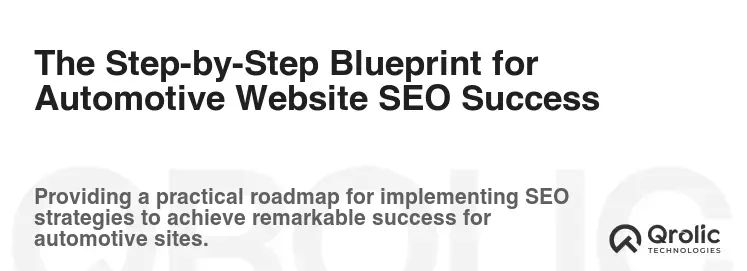
Achieving first-page rankings for your automotive website requires a systematic, disciplined approach. Qrolic recommends this comprehensive, step-by-step blueprint to ensure no stone is left unturned.
Step 1: Comprehensive Keyword Research for the Automotive Niche
This is the foundation of all your SEO efforts. You need to understand what terms your target customers are actually typing into Google.
Identifying High-Intent Automotive Keywords (Long-tail, LSI)
- Seed Keywords: Start with broad terms like “new cars,” “auto repair,” “car parts.”
- Long-tail Keywords: These are longer, more specific phrases (e.g., “reliable family SUV for sale in Phoenix,” “cost of replacing catalytic converter Honda Civic”). They have lower search volume but higher conversion rates because they reflect specific user intent.
- LSI (Latent Semantic Indexing) Keywords: These are related terms that help Google understand the context of your content (e.g., for “brake repair,” LSI keywords might include “rotor replacement,” “caliper service,” “brake fluid flush”).
- Question-Based Keywords: Many searches are questions (e.g., “How much is an oil change?”, “What’s the best tire brand for snow?”). Optimize for these to appear in featured snippets.
Competitor Keyword Analysis
Examine what keywords your top-ranking automotive competitors are targeting. What are they doing well? Where are their gaps? This can reveal untapped opportunities.
Tools for Automotive Keyword Research
- Google Keyword Planner: Free and excellent for identifying keyword ideas and estimated search volumes.
- SEMrush, Ahrefs, Moz Keyword Explorer: Premium tools offering in-depth analysis, competitor insights, and more.
- Google Search Console: Shows you what queries users are already using to find your site.
- Google Trends: Helps identify emerging trends and seasonal search patterns (e.g., “winter tire deals”).
Step 2: On-Page SEO Mastery for Automotive Content
Once you have your keywords, you need to strategically integrate them into your website’s content and structure to signal relevance to search engines.
Crafting Compelling Title Tags and Meta Descriptions
- Title Tag (
): This is what appears in the browser tab and as the main clickable headline in search results. It must include your primary keyword, be compelling, and ideally be under 60 characters.- Example: “Used Cars for Sale in [City] | [Dealership Name]” or “Expert Brake Repair & Service | [Shop Name]”
- Meta Description (): This is the short summary beneath the title tag in search results. While not a direct ranking factor, it’s crucial for click-through rate (CTR). Include your keywords naturally and write an enticing summary (under 160 characters) that encourages clicks.
- Example: “Discover quality used cars and trucks in [City]. Browse our extensive inventory, schedule a test drive, and get financing options today!”
Optimizing Headings (H1-H6)
Headings break up your content and signal its structure to both users and search engines.
- H1: Use only one H1 per page, including your primary keyword. This should be your page’s main topic.
- H2, H3, etc.: Use these to organize sub-sections, naturally incorporating related keywords and variations.
High-Quality Content Creation: Vehicle Descriptions, Service Pages, Blog Posts
As discussed, content is paramount.
- Vehicle Descriptions: Go beyond basic features. Highlight benefits, tell a story, include 360-degree views, high-resolution images, video walk-arounds, and customer testimonials. Use schema markup for vehicles.
- Service Pages: Explain the service, its importance, what’s involved, and why customers should choose your shop. Include FAQs.
- Blog Posts: Consistently publish valuable content that answers customer questions, provides buying advice, or discusses automotive trends. This establishes your expertise and creates more opportunities to rank for long-tail keywords.
Image Optimization for Automotive Galleries
Automotive websites are visual-heavy. Optimize your images for speed and SEO.
- File Size: Compress images without sacrificing quality to improve loading times.
- Alt Text: Provide descriptive alt text for every image (e.g.,
alt="2023 Honda CR-V Touring model in Lunar Silver Metallic"). This helps search engines understand image content and is crucial for accessibility. - Descriptive File Names: Use relevant names (e.g.,
honda-crv-silver-front-view.jpginstead ofIMG00123.jpg).
Internal Linking Strategies
Internal links connect pages within your own website, helping spread “link juice” (ranking power), defining your site’s hierarchy, and improving user navigation.
- Optimization Tips: Link from high-authority pages to important vehicle or service pages. Use descriptive anchor text (the clickable text of the link) that includes relevant keywords.
Step 3: Technical SEO Implementation and Auditing for Automotive Websites
Regularly check under the hood of your website to ensure it’s running smoothly for search engines.
Conducting a Technical SEO Audit
Use tools like Google Search Console, Screaming Frog, or Ahrefs Site Audit to identify issues such as:
- Broken links
- Crawl errors
- Duplicate content
- Missing meta descriptions or title tags
- Slow loading pages
- Incorrect redirects
Fixing Crawl Errors and Indexing Issues
Ensure all your important automotive pages are discoverable and indexed by Google. Address any “noindex” tags or robots.txt directives that are unintentionally blocking important content.
Implementing Structured Data for Automotive
Go beyond basic schema. Implement specific automotive schema types for your inventory, dealership information, services, and reviews. This helps Google create rich snippets, which grab attention in SERPs. Qrolic emphasizes this for competitive differentiation.
Step 4: Building a Robust Backlink Profile for Your Automotive Site
Acquiring high-quality backlinks is often the most challenging but rewarding aspect of SEO. It takes time and effort.
Content-Based Link Building (Guest Posting, Infographics)
- Guest Posting: Write valuable articles for other reputable automotive blogs or industry websites, including a link back to your site in your author bio or within the content (where relevant).
- Infographics and Visual Content: Create compelling visuals related to automotive trends, statistics, or buying guides. Promote them to other sites that might embed or link to them.
Local Partnerships and Sponsorships
Sponsor local events, charities, or sports teams. Often, the organizations you support will link back to your website from their “sponsors” page, providing valuable local backlinks. Collaborate with local mechanics, detailers, or parts suppliers if you are a dealership, or vice versa.
Broken Link Building
Find broken links on authoritative automotive websites using tools like Ahrefs. Reach out to the webmaster and suggest replacing the broken link with a link to your relevant, high-quality content.
Step 5: Dominating Local Search with Automotive-Specific Strategies
Beyond basic GMB optimization, there are advanced tactics to truly own your local market.
Advanced GMB Optimization Tactics
- Utilize GMB Posts: Regularly post updates about new inventory, special offers, events, or service discounts directly to your GMB profile.
- Q&A Section: Actively monitor and answer questions in your GMB profile. You can even pre-populate common questions.
- Product/Service Listings: If applicable, list specific products (e.g., tires, specific car models) or services (e.g., alignment, diagnostic checks) within your GMB profile.
- Virtual Tour: If possible, add a 360-degree virtual tour of your dealership or shop.
Encouraging and Responding to Reviews
Online reviews are critical for local SEO and customer trust.
- Proactive Solicitation: Encourage satisfied customers to leave reviews on Google, Yelp, and other relevant platforms. Provide easy ways for them to do so.
- Respond to All Reviews: Positive or negative, respond professionally and promptly. This shows you value customer feedback and are attentive. Address negative reviews constructively and offer solutions.
Local Landing Pages
For automotive businesses with multiple locations or a wide service area, dedicated landing pages for each location or service are essential.
- Optimization Tips: Each page should have unique, locally-focused content, including local keywords, address, phone number, unique selling points for that location, and embedded Google Maps.
Step 6: User Experience (UX) and Conversion Rate Optimization (CRO)
A high-ranking automotive website is only valuable if it converts visitors into customers. UX and CRO go hand-in-hand.
Intuitive Navigation and Clear Calls-to-Action
- Easy Navigation: Ensure visitors can quickly find what they’re looking for, whether it’s inventory, service scheduling, or contact information. Use clear menus and search functionality.
- Prominent CTAs: Make it obvious what you want users to do next. “Schedule Test Drive,” “Request a Quote,” “View Inventory,” “Book Service Appointment” should be strategically placed and visually distinct.
Fast Loading Times and Mobile Responsiveness
Reiterating these crucial points: a slow or non-mobile-friendly site will cause high bounce rates, negating all your SEO efforts. Regularly test your site speed and mobile usability.
Personalized User Journeys
Consider personalizing the user experience. Can you show different offers based on a user’s location? Can you recommend vehicles based on their previous browsing history? Tools can help with this, improving engagement and conversion rates.
Advanced Automotive Website SEO Strategies to Outpace Competition
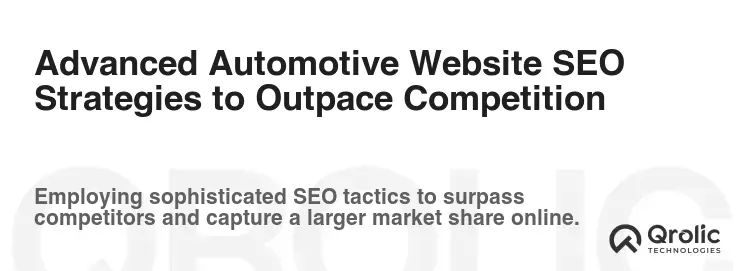
Once you’ve mastered the fundamentals, it’s time to explore cutting-edge strategies that will truly set your automotive business apart. Qrolic’s advanced tactics help clients dominate search results.
Voice Search Optimization for Automotive Queries
The rise of virtual assistants like Siri, Alexa, and Google Assistant means more people are using natural language queries to find information.
- Optimization Tips: Focus on conversational, long-tail keywords (e.g., “Where can I get an oil change for a Honda CR-V near me?”). Structure content to answer direct questions, making it ideal for voice search.
- Featured Snippets: Optimize for featured snippets (“Position Zero”), as voice search often pulls answers directly from these.
Video SEO: Showcasing Vehicles and Services
Video content is highly engaging and increasingly important for SEO, especially in the automotive industry.
- Optimization Tips: Host videos on YouTube (the second-largest search engine) and embed them on your website. Optimize YouTube videos with relevant keywords in titles, descriptions, and tags. Include transcripts.
- Content Ideas: Vehicle walk-arounds, test drives, service explanations, customer testimonials, “how-to” guides (e.g., “how to check your tire pressure”).
E-A-T Principles for Automotive Authority
Google’s E-A-T (Expertise, Authoritativeness, Trustworthiness) guidelines are critical, particularly for “Your Money or Your Life” (YMYL) topics, which include automotive purchases and services.
- Optimization Tips:
- Expertise: Showcase your team’s certifications, experience, and knowledge.
- Authoritativeness: Get mentions and links from reputable industry sources. Publish well-researched content.
- Trustworthiness: Build positive reviews, ensure secure transactions, display clear privacy policies, and be transparent.
International SEO (if applicable)
If your automotive business operates in multiple countries or serves a global audience (e.g., exotic car imports, specialty parts), international SEO is crucial.
- Optimization Tips: Use
hreflangtags to indicate language and geographical targeting. Consider ccTLDs (country code top-level domains like .ca, .de) or subdirectories (e.g., example.com/ca/).
Leveraging AI in Automotive SEO
Artificial intelligence is rapidly changing the SEO landscape.
- AI-powered Content Generation (with human oversight): AI tools can assist in generating blog post ideas, outlines, and even draft content, saving time. However, human review and refinement are essential to ensure accuracy, tone, and E-A-T.
- Data Analysis: AI can help analyze vast amounts of SEO data more efficiently, identifying patterns and opportunities that humans might miss.
- Personalization: AI can help deliver personalized content and offers to website visitors based on their behavior, improving engagement and conversions.
Measuring Your Automotive SEO Success: Key Metrics and Tools

SEO is an ongoing process, and continuous monitoring and analysis are vital. You need to know if your efforts are paying off and where adjustments are needed. Qrolic emphasizes data-driven decision-making.
Essential SEO Metrics for Automotive Businesses
Organic Traffic and Conversions
- Organic Traffic: The number of visitors coming to your site from organic search results. This is a primary indicator of visibility.
- Conversion Rate: The percentage of organic visitors who complete a desired action (e.g., fill out a form, call, schedule a test drive, request a quote). This directly impacts your ROI.
Keyword Rankings
Track your position in search results for your target keywords. While individual rankings fluctuate, overall improvements across a broad set of keywords indicate progress.
Domain Authority/Rating
Metrics from tools like Moz or Ahrefs that estimate the overall strength and authority of your website. Improvements here often correlate with better rankings.
Local Pack Rankings
For automotive businesses, tracking your visibility in the local pack (the map results) is crucial for local lead generation.
Indispensable Tools for Automotive SEO Analytics
Google Analytics 4 (GA4)
GA4 is Google’s latest analytics platform, focusing on event-based data. It’s essential for tracking user behavior, traffic sources, conversions, and understanding how visitors interact with your automotive website.
- Key Uses: Monitor organic traffic trends, identify top-performing pages, track goal completions (e.g., form submissions), and analyze user engagement.
Google Search Console
This is your direct line to Google. It provides invaluable insights into your website’s performance in search results.
- Key Uses: See which queries users are searching for to find your site, monitor indexing status, identify crawl errors, check for manual actions, and submit sitemaps.
Local SEO Tools
- Google My Business Insights: Provides data on how customers are finding your GMB profile (direct, discovery, branded) and what actions they’re taking (calls, website visits, direction requests).
- Local Rank Trackers: Tools like BrightLocal or Whitespark help track your local rankings for specific keywords across different locations.
Rank Tracking Software
Tools like SEMrush, Ahrefs, or Moz offer detailed keyword rank tracking, allowing you to monitor your performance for hundreds or thousands of keywords over time.
When to Expect Results from Your Automotive SEO Efforts
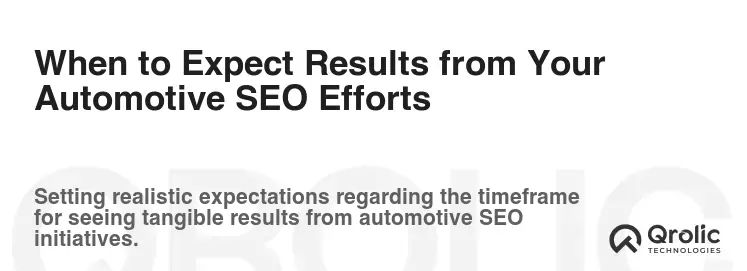
One of the most common questions about SEO is “How long will it take?” The answer, frustratingly, is “it depends.” However, Qrolic can provide realistic expectations.
Understanding the SEO Timeline: Patience is a Virtue
SEO is a long-term strategy, not a quick fix. You won’t see dramatic changes overnight.
- Initial Improvements (1-3 months): You might start to see improvements in technical SEO health, increased keyword rankings for some long-tail terms, and a modest bump in organic traffic.
- Significant Growth (4-9 months): With consistent effort, you should begin to see more substantial improvements in overall organic traffic, conversions, and rankings for more competitive keywords.
- Dominant Positions (10-18+ months): For highly competitive automotive keywords, achieving and maintaining first-page rankings can take a year or more of dedicated, ongoing effort.
Factors Influencing Your Ranking Speed
- Website Age and Authority: Newer websites will generally take longer to rank than established sites with existing authority.
- Competition: The more competitive your local or national automotive market, the harder and longer it will be to rank.
- Budget and Resources: The more time, effort, and investment you put into SEO, the faster you’re likely to see results.
- Current Website Health: If your website has significant technical issues or penalties, it will take longer to recover and build momentum.
- Algorithm Updates: Google constantly updates its algorithm, which can cause temporary fluctuations in rankings. Adapting to these changes is part of ongoing SEO.
Qrolic Technologies: Your Trusted Partner in Automotive Website SEO Excellence
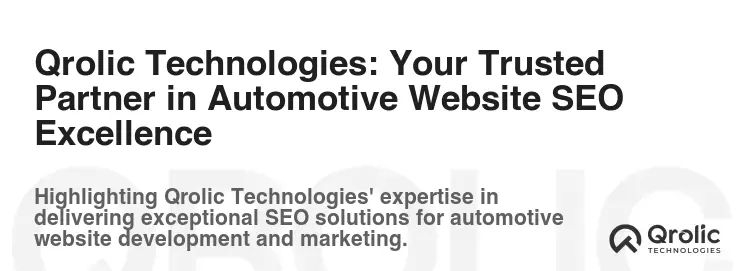
Navigating the complexities of automotive website SEO can feel like trying to fix a high-performance engine without the right tools or expertise. That’s where Qrolic Technologies steps in. With a proven track record and deep understanding of the digital automotive landscape, Qrolic is uniquely positioned to drive your business to the forefront of Google’s search results.
Who is Qrolic Technologies?
Qrolic Technologies (https://qrolic.com/) is a leading digital marketing agency specializing in delivering comprehensive, results-driven SEO solutions. Our team of seasoned experts lives and breathes search engine optimization, constantly adapting to Google’s ever-evolving algorithms and the specific demands of diverse industries, including the dynamic automotive sector. We combine technical prowess with creative strategy to build sustainable online success for our clients.
How Qrolic Elevates Automotive Businesses to Google’s First Page
At Qrolic, we understand that every automotive business is unique, from bustling multi-franchise dealerships to specialized auto repair shops. Our approach is never one-size-fits-all.
- Deep-Dive Automotive Audit: We start with a meticulous audit of your current website, competitors, and market landscape. This uncovers immediate opportunities and long-term strategic pathways tailored specifically for your automotive niche.
- Customized SEO Strategy: Leveraging our extensive experience, we craft a bespoke SEO strategy that aligns with your business goals, target audience, and local market dynamics. This includes detailed keyword research, technical SEO roadmaps, content strategies, and comprehensive backlink acquisition plans.
- Local SEO Domination: For automotive businesses, local visibility is paramount. Qrolic excels in optimizing Google My Business profiles, managing local citations, and building geo-targeted content that ensures you’re the first choice for “near me” searches.
- Content Excellence: We don’t just optimize existing content; we help you create compelling, authoritative, and engaging content – from detailed vehicle descriptions and service pages to insightful blog posts – that resonates with your target buyers and satisfies search engine requirements.
- Technical Prowess: Our technical SEO specialists ensure your automotive website is a well-oiled machine, addressing speed, mobile-friendliness, schema markup, and site architecture to provide a flawless user experience and optimal crawlability for search engines.
- Transparent Reporting and Communication: We believe in complete transparency. You’ll receive regular, easy-to-understand reports detailing your progress, keyword rankings, organic traffic, and conversions, along with clear explanations of our ongoing strategies.
Qrolic’s Proven Approach and Expertise
Our success stems from a blend of data-driven insights, proactive strategy, and a relentless focus on client ROI. Qrolic’s automotive SEO experts possess:
- Industry-Specific Knowledge: We understand the nuances of the automotive market, from seasonal buying trends to the specific search queries related to vehicle makes, models, and repair services.
- Proprietary Methodologies: We leverage cutting-edge tools and refined processes to identify the most impactful SEO opportunities for your business.
- Dedicated Support: Our clients benefit from direct access to their SEO strategists, ensuring continuous alignment and responsive adjustments to strategies as needed.
- Holistic Digital Marketing Integration: While specializing in SEO, we understand its synergy with other digital marketing channels. Our strategies often complement and enhance your overall online presence for maximum impact.
Partnering with Qrolic Technologies means entrusting your automotive website’s future to a team dedicated to securing your top spot on Google’s first page, driving qualified leads, and achieving sustainable growth for your business.
The Future of Automotive Website SEO: Staying Ahead of the Curve
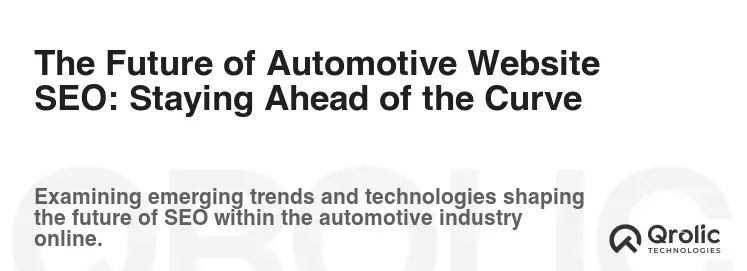
The digital landscape is constantly evolving, and automotive website SEO is no exception. To maintain your first-page rankings and continue attracting new customers, it’s essential to keep an eye on emerging trends.
AI and Machine Learning’s Growing Influence
Google’s algorithms are increasingly powered by AI and machine learning (e.g., RankBrain, BERT, MUM). This means:
- Contextual Understanding: Google understands queries more deeply, focusing on intent rather than just keywords.
- Content Quality: AI helps identify high-quality, comprehensive content that truly answers user questions.
- User Behavior Signals: AI analyzes how users interact with your site (dwell time, bounce rate) to determine relevance.
- Proactive Strategy: As mentioned, AI tools can also assist in content generation and data analysis, making SEO more efficient.
Personalization and Hyper-Localization
Search results are becoming increasingly personalized based on user location, search history, and preferences.
- Optimization Tips: Continue to invest heavily in local SEO. Implement advanced personalization features on your website to cater to individual user needs and preferences, such as dynamic content or tailored recommendations.
Continued Emphasis on User Experience
User experience will remain a dominant factor. Google wants to send users to websites that provide a seamless, enjoyable, and efficient experience.
- Optimization Tips: Prioritize site speed, mobile responsiveness, intuitive navigation, engaging content, and accessibility. A delightful user experience is the ultimate goal of SEO.
Final Thoughts: Drive Your Automotive Business to Digital Dominance

The journey to Google’s first page for your automotive website is a marathon, not a sprint. It requires dedication, continuous effort, and a deep understanding of how search engines work and what users truly desire. By implementing the comprehensive SEO strategies outlined here – from meticulous keyword research and technical optimization to building authority and enhancing user experience – you are not just striving for higher rankings; you are building a robust, resilient, and perpetually growing online presence for your automotive business.
Remember, every step you take in optimizing your automotive website moves you closer to connecting with high-intent customers, fostering trust, and ultimately, driving more sales and service appointments. Don’t let your competitors dominate the digital highway. Embrace the power of automotive website SEO, leverage Qrolic’s expert tips, and steer your business confidently towards unparalleled online success. The first page of Google isn’t just a destination; it’s the starting line for sustained digital dominance.









